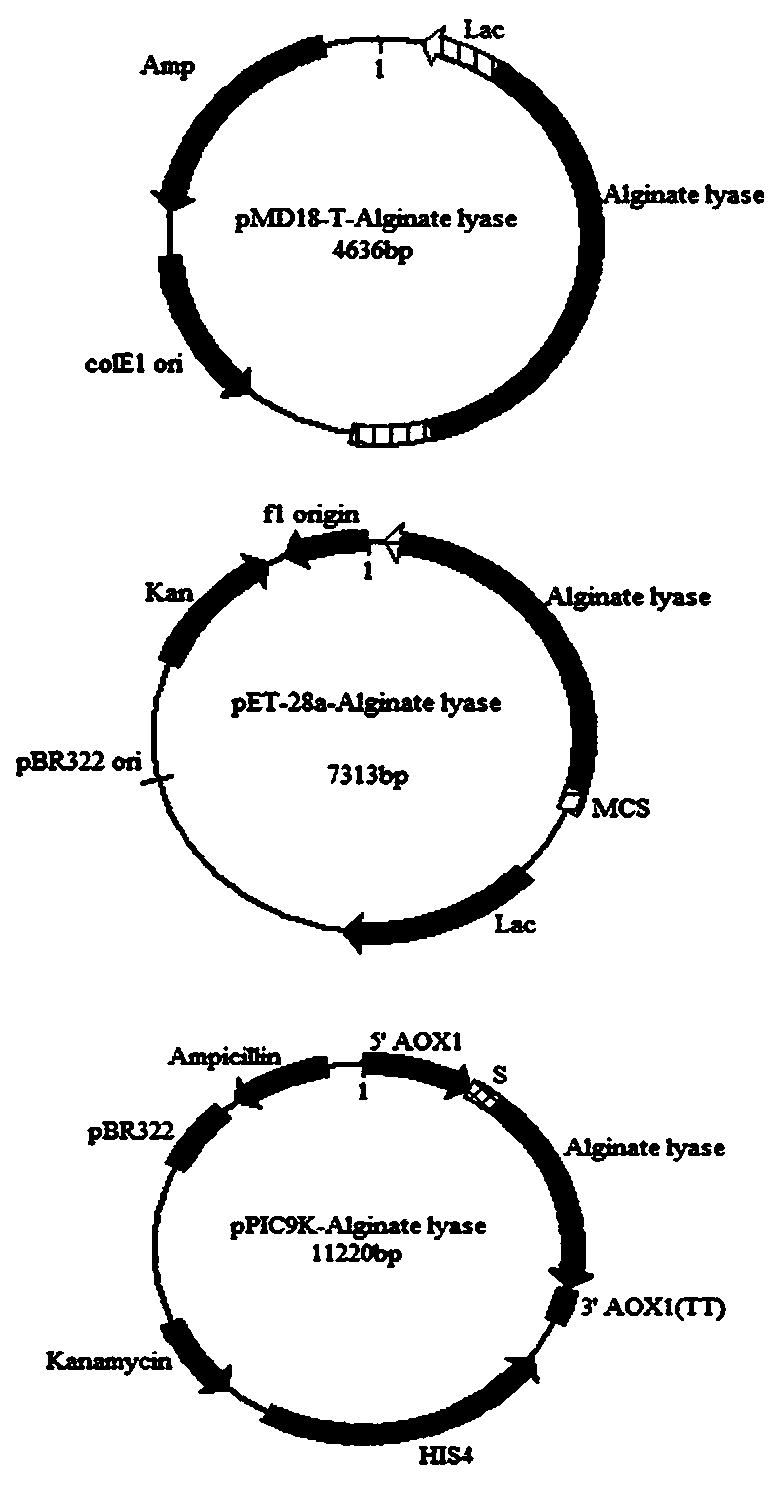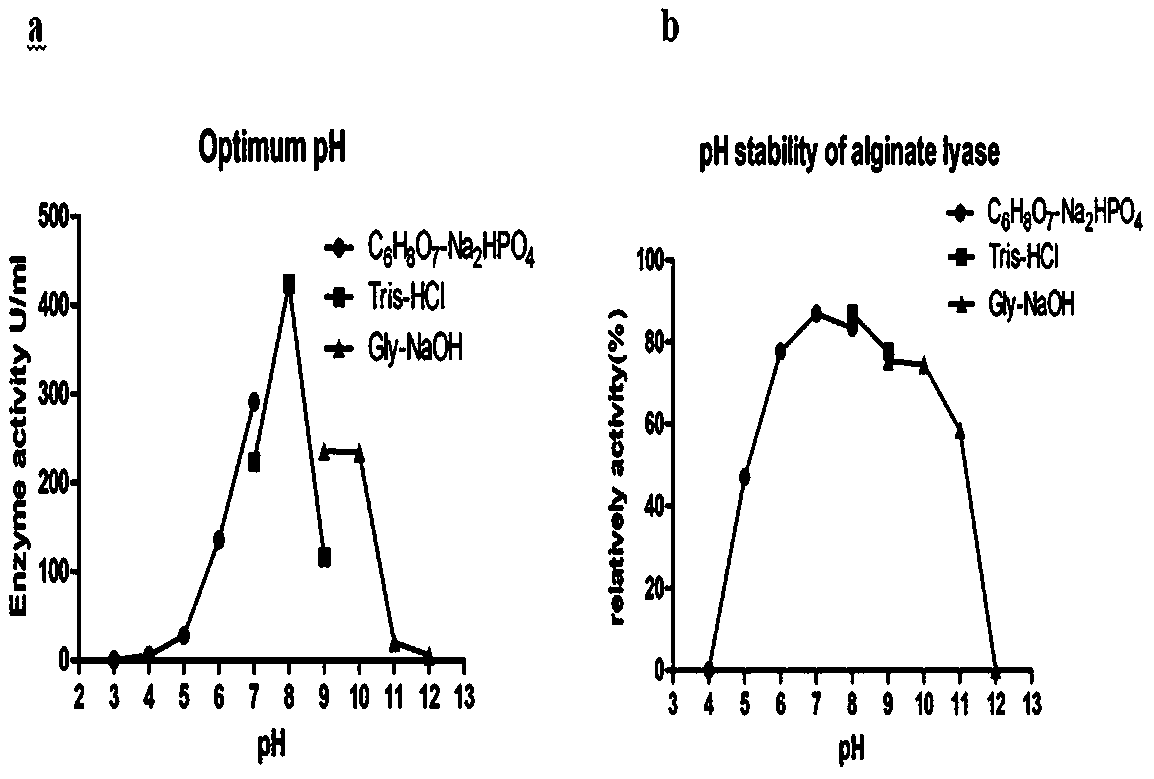Alginate lyase and gene and application thereof
An alginate lyase, gene technology, applied in the directions of lyase, application, genetic engineering, etc., can solve the problems of long growth cycle, enzyme inactivation, enzyme activity reduction, etc., and achieve high activity, long-lasting stability, temperature adaptability, etc. strong effect
- Summary
- Abstract
- Description
- Claims
- Application Information
AI Technical Summary
Problems solved by technology
Method used
Image
Examples
Embodiment 1
[0038] Example 1 Alginate lyase Gene acquisition
[0039] (1) Derived from Microvesicles Microbulbifer sp .Isolation and extraction of genomic DNA:
[0040] Take 1.5 mL of the cell culture Microbulbifer sp. (purchased from China Marine Microorganism Culture Collection Management Center) in a sterilized Ep tube, centrifuge at 12000 rpm for 1 min, discard the supernatant, and collect the cells.
[0041] Add 400 μL of lysate solution (40 mM Tris-acetic acid, 20 mM sodium acetate, 1 mM EDTA, 1% SDS, pH 7.8), mix well, and place in a 37°C water bath for 1 h.
[0042] Then add 200 μL of 15 mol / L sodium chloride solution, mix well and centrifuge at 13000 rpm for 15 min.
[0043] Take the supernatant, extract twice with phenol and once with chloroform.
[0044] Add twice the volume of absolute ethanol and 1 / 10 volume of potassium acetate (3 M, pH 8.0), store at -20°C for 1 h, centrifuge at 13,000 rpm for 15 min, discard the supernatant, and wash the precipitate twice with 70% et...
Embodiment 2
[0055] Example 2 Alginate lyase Expression and amplification of coding genes in Escherichia coli
[0056] With the result obtained in embodiment 1-(4) Hind III and Bam H I double-enzyme-digested target gene, and Hind III and Bam H The pET28a (+) plasmid of I double digestion is ligated to obtain the recombinant plasmid pET-28a -Alginate lyase (like figure 1 shown).
[0057] Take 10uL of the constructed plasmid DNA and add it to 100uL of the prepared Escherichia coli BL21(DE3) competent cells. Shake well and place on ice for 30 minutes; heat shock in a water bath at 42°C for 90 seconds; place the centrifuge tube quickly Transfer to ice-water mixture for ice bath for 2min; add 800uL LB medium to each tube, lightly aspirate and disperse with a pipette, and recover on a shaker at 37°C for 1h (80rpm-200rpm); centrifuge at 4000rpm×5min, remove 700uL supernatant , and mix the rest; smear the plate (LB plate, containing 100ug / mL Amp), place it upright at 37°C for 1 hour, ...
Embodiment 3
[0059] Example 3 Construction of Yeast Recombinant Expression Vector
[0060] The result obtained in embodiment 1-(4) Avr II and not I double-enzyme-digested target gene, and Avr II and not I double-digested pPIC9k plasmid connection to obtain recombinant plasmid pPIC9k -Alginate lyase (like figure 1 shown).
[0061] Transfer the recombinant plasmid into E. coli Top10 competent cells were spread on the LB screening plate containing 100 mg / mL Amp and cultured overnight, and the recombinants were picked into liquid LB (containing 100ug / mL Amp), and identified by bacterial liquid PCR, if they were positive recombinants , Sent for sequencing, the sequencing results further prove the correctness of the target gene sequence and insertion site. Select the bacterial solution with the correct inserted gene, follow the extraction steps of the OMEGA Plasmid Mini Kit, extract the recombinant plasmid, and store it at -20°C for later use.
PUM
 Login to View More
Login to View More Abstract
Description
Claims
Application Information
 Login to View More
Login to View More - Generate Ideas
- Intellectual Property
- Life Sciences
- Materials
- Tech Scout
- Unparalleled Data Quality
- Higher Quality Content
- 60% Fewer Hallucinations
Browse by: Latest US Patents, China's latest patents, Technical Efficacy Thesaurus, Application Domain, Technology Topic, Popular Technical Reports.
© 2025 PatSnap. All rights reserved.Legal|Privacy policy|Modern Slavery Act Transparency Statement|Sitemap|About US| Contact US: help@patsnap.com



